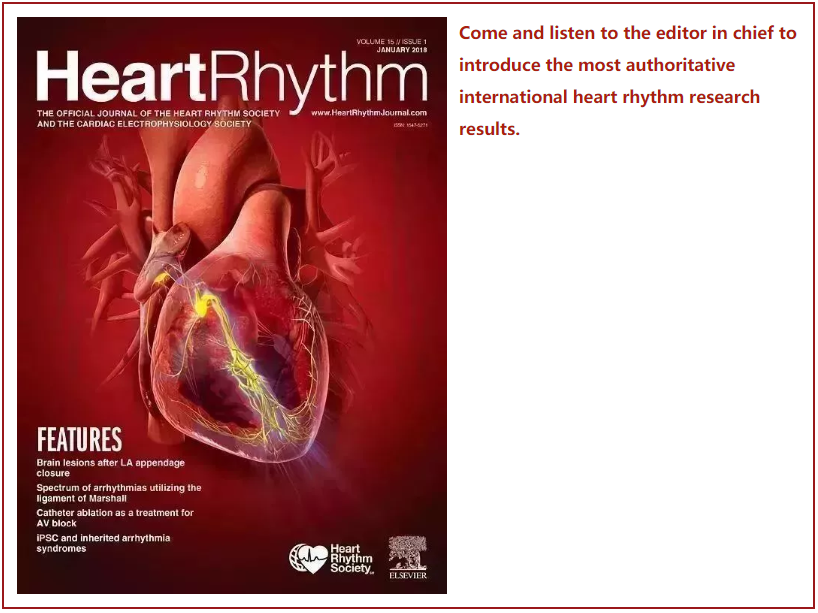Heart Rhythm主编—陈鹏生教授语音速递(十月刊 英文版)
<< First issue in Oct 2018 >>


1
The featured article this month is titled “Coronary artery compression from epicardial leads: More common than we think” by Mah et al., from Boston Children's Hospital. An accompanying video author interview conducted by our online editor, Dr. Daniel Morin, can be found at the www.heartrhythmjournal.com website. In this study, all patients with epicardial leads who underwent catheter angiography and computed tomography were retrospectively reviewed. Coronary compression was noted in 8 of 145 patients (5.5%) with epicardial leads. The median age at diagnosis was 11 years. Among those with coronary compression, 6 of 8 (75%) had symptoms, including 1 sudden death, 3 patients with chest pain including 2 with associated troponinemia, and 2 had unexplained fatigue. Seven patients underwent surgical repositioning of their lead. The authors conclude that they found a higher incidence of coronary artery compression by epicardial leads than previously reported in the literature. Epicardial leads are being used both in pediatric and in adult EP practice. This paper shows that one in 20 patients may suffer from coronary artery compression and its complications. Coronary artery compression needs to be included in the differential diagnosis for patients who are symptomatic after epicardial lead implantation – even long after.
2
The October issue is a focus issue on sudden death. The first article is written by Junttila et al., titled “Type 2 diabetes and coronary artery disease: preserved ejection fraction and sudden cardiac death”. The data came from a prospective observational study called ARTEMIS including 834 subjects with type 2 diabetes and 1112 subjects without diabetes. During a mean follow-up of 6.3 years, sudden cardiac death or sudden cardiac arrest occurred in 50 patients. The prevalence was higher in diabetic patients than in nondiabetic patients, with a hazard ratio of 2.6. However, the non-sudden death component of cardiac mortality was not significantly different between these two groups. The authors conclude that type 2 diabetes is an independent risk factor for sudden cardiac death or sudden cardiac arrest in CAD patients with preserved ejection fraction. An important lesson is that diabetes patients with CAD are at high risk of sudden death even if they have a preserved ejection fraction.
3
The next paper is titled “Gender differences in patients with Brugada syndrome and arrhythmic events: Data from a survey on arrhythmic events in 678 patients”by Milman et al. from Tel Aviv University, Israel. The authors performed a multicenter survey on arrhythmic events in Brugada Syndrome. In Asians, the male to female ratio for arrhythmic events was about 9-fold higher than that in Whites. A spontaneous type 1 Brugada ECG was associated with an earlier onset of arrhythmic events in pediatric females. Females less frequently showed spontaneous type 1 Brugada ECG or arrhythmia inducibility at electrophysiology study. 48% of females with arrhythmic events were carriers of an SCN5A mutation, as compared with only 23% of males. This study confirms that female patients with Brugada Syndrome are much rarer, less frequently display a type 1 Brugada ECG, and exhibit lower inducibility rates than do males. It is interesting to note that the male predominance in arrhythmic events is much larger in Asians than in Whites. The latter findings pose significant challenges to geneticists and basic scientists in their search for the molecular mechanisms of Brugada syndrome.
4
The next article is written by Morita et al, from Okayama University, Japan. The title of the paper is “Progression of electrocardiographic abnormalities associated with initial ventricular fibrillation in asymptomatic patients with Brugada syndrome”. The subjects of this study included 14 patients with VF and 48 consecutive asymptomatic patients, all with Brugada Syndrome. They defined “early phase” ECGs as ECGs taken>6 months before VF. Late phase ECGs are ECGs taken during the initial VF event. ECG parameters of the early and late phases were not different except for decreased ST voltage and low incidence of type 1 ECG in asymptomatic patients. In patients with VF, ECGs at the late phase had longer QRS intervals and intervals between the peak and the end of the T wave and more frequent type 1 ECG and fragmented QRS than did ECGs at the early phase. The authors conclude that QRS and ST-T wave abnormalities developed in association with the initial VF events. Aggravation of the conduction disturbance in addition to BrS-ECG promotes VF. These findings suggest that there may be progression of diseases from one time point to the other. However, without a prospective study, it is difficult to confirm that these changes were due to progression of disease rather than due to transient and preventable clinical factors.
5
Next up is a paper titled “A 10-year review of sudden death during sporting activities” by Dennis et al., from University of Sydney, Australia. The authors reviewed all autopsies conducted at their forensic medicine facility between 2006 and 2015. A total of 19,740 autopsies were completed in the study period. There were 201 sports-related adult deaths, at an incidence rate of 0.76-1.49 per 100,000 participant-years. Of the adult cases, 68% were due to cardiac causes, with coronary artery disease the most frequent cause. Of the 15 child deaths, 33% were arrhythmic or presumed arrhythmic, and 33% were related to inherited cardiomyopathies. The authors conclude that sudden cardiac death during sport is rare. Deaths are mostly due to coronary artery disease in adults, and cardiomyopathy or arrhythmia in children. A limitation is that this study was retrospective. Some of the premorbid conditions may not be included in the report. Therefore, it is unclear if these deaths could have been prevented.
6
Up next is a paper by Minami et al from Tokyo Women's Medical University, in Japan. The paper is titled “B-type natriuretic peptide and risk of sudden death in patients with hypertrophic cardiomyopathy”. The authors measured plasma BNP levels at the initial evaluation in 346 patients with hypertrophic cardiomyopathy. The median BNP level in the study patients was 197.2 pg/mL. During a median follow-up period of 8.4 years, 37 patients experienced the combined end point of sudden death or potentially lethal arrhythmic events. Patients with BNP levels>312 pg/mL were at a significantly higher risk of sudden death and the combined end point than were patients with low BNP levels. Multivariable analysis showed that high BNP levels were an independent determinant of the combined end point. The authors conclude that elevated BNP levels may be associated with sudden death and the combination of sudden death or potentially lethal arrhythmic events in patients with hypertrophic cardiomyopathy. The journal has previously published two papers on BNP and sudden death. In 2014, Levine et al. reported BNP is independently associated with ventricular arrhythmias in patients with ICDs, and Medina et al. reported in 2016 that BNP was an independent risk factor for ventricular arrhythmias in the MADIT-CRT population. All three studies suggest that BNP is important in arrhythmia risk stratification.
7
Up next is a paper titled “A QRS axis–based algorithm to identify the origin of scar- related ventricular tachycardia in the 17-segment American Heart Association model” by Andreu et al., from Barcelona, Spain. The authors used a frontal plane axis-based ECG algorithm, together with the polarity in leads V3 and V4, to predict the segment of origin of VT. The results were compared with the site of origin determined during invasive EP mapping procedures. The ECG correctly predicted the segment of origin 82% of the time. There were no differences in the accuracy of the algorithm based on the segment of origin or the type of structural heart disease. The authors conclude that this novel QRS axis-based algorithm accurately identifies the segment of origin of VT in the 17-segment American Heart Association model. Non-invasive determination of the origin of VT based on surface ECG is an important but difficult task. I can refer the readers to an accompanying editorial written by Bazan and Marchlinski, who review multiple other ECG algorithms and suggest possible further improvements of the ECG criteria.
8
Muser et al. from University of Pennsylvania wrote the following article, titled “Outcomes with prophylactic use of percutaneous left ventricular assist devices in high-risk patients undergoing catheter ablation of scar-related ventricular tachycardia: A propensity-matched analysis”. The authors studied 45 high-risk patients who received percutaneous left ventricular assist devices, or “pLVADs,” while undergoing catheter ablation of scar-related VT. They also included a control population with similarly high risk but without prophylactic pLVAD placement. Periprocedural acute hemodynamic decompensation occurred in 7% in the prophylactic pLVAD group and in 23% in the control group. The subsequent 12-month cumulative incidence of VT was not different, but the 12-month incidence of death or transplant was 33% vs. 66%, respectively. In multivariable analysis, prophylactic pLVAD was independently associated with death or transplant. The authors conclude that prophylactic pLVAD placement in high-risk patients undergoing catheter ablation of scar-related VT is associated with a reduced risk of acute hemodynamic decompensation and death or transplant during follow-up without affecting VT-free survival. Future prospective randomized trials are needed to confirm the results of their study.
9
Next up is a paper titled “Ventricular fibromas in children, arrhythmia risk, and outcomes: A multicenter study” by Jones et al. from University Hospital Bristol, in Bristol, United Kingdom. Ventricular fibromas are the second most common type of cardiac tumor in children. The authors report on a total of 19 patients with fibromas. Arrhythmias were common, with 5 patients presenting with cardiac arrest and 5 others having documented ventricular tachycardia. Nine of these patients have undergone surgical resection at various hospitals, and all these patients have survived with good long-term outcomes. There were no recurrences of arrhythmia after surgery, and the need for a defibrillator was alleviated in all cases. The authors conclude that ventricular fibromas have a high propensity to cause malignant arrhythmias, and if they are not managed appropriately, mortality is high. The outcomes of surgical resection are good, regardless of tumor size, and this represents the best therapeutic option, with most patients being symptom-free on the long term. An important lesson from this case series is that preventative surgical resection is associated with good clinical outcomes. This is particularly true in small children, among whom the complication rate of ICDs remains high.
10
The next paper is “Prospective blinded evaluation of a novel sensing methodology designed to reduce inappropriate shocks by the subcutaneous implantable cardioverter-defibrillator” by Theuns et al., of Erasmus University Medical Center, in Rotterdam, The Netherlands. The purpose of this study was to evaluate the effects of a new high pass filter, called “SMART Pass,” on shock frequency in ambulatory patients with the subcutaneous ICD. The study cohort consisted of 1984 patients, and a total of 880 shocks were adjudicated. At implantation, SMART Pass was enabled in one third of the patients. The results showed that SMART Pass reduced the risk for all inappropriate shocks by 68%. The incidence of inappropriate shocks was 4.3% in the SMART Pass enabled arm vs. 9.7% in the SMART Pass disabled arm. The incidence of appropriate shocks was similar, as was the time to treat the first appropriate shock, between groups. The authors conclude that the SMART Pass filter reduces inappropriate shocks from the subcutaneous ICD without a negative effect on delivery of appropriate shocks. An accompanying editorial by Swerdlow points out that in transvenous ICDs, some high-pass filters have been associated with failure to treat VF. Thus, there is reason for caution. The present study is an encouraging first step to eliminate a major problem of subcutaneous ICD, that is, inappropriate shocks. However, more data will be needed to further confirm the clinical benefit of the new high pass algorithm.
11
Houston et al. from the Medical University of South Carolina wrote the following article titled “Acute biventricular hemodynamic effects of cardiac resynchronization therapy in right bundle branch block”. Forty patients (9 with RBBB and 31 with LBBB) undergoing CRT implantation underwent temporary pacing with varying pacing configurations and AV delay. The results show that patients with LBBB had a greater LV dP/dt maximum response to CRT than did patients with RBBB. In patients with RBBB, single- or dual-site RV pacing configurations resulted in greater increases in RV dP/dt(max) than did biventricular pacing. Optimal AV delays that maximized RV dP/dt(max) were shorter than optimal AV delays for LV dP/dt(max). Furthermore, AV delays chosen to maximize improvement in RV dP/dt(max) frequently resulted in negative effects on LV dP/dt(max). The authors conclude that the biventricular hemodynamic response in heart failure patients with RBBB might be improved by optimizing pacing modalities and AV delays. This may be particularly important in patients in whom RV failure predominates, such as patients with pulmonary hypertension and LV assist devices. Because RV failure is a clinical problem without any good solution available, the findings reported in the present study may lead to the improvement of device management in those patients.
12
The next article is “Prognostic value of global longitudinal strain in heart failure patients treated with cardiac resynchronization therapy” by Khidir et al., from Leiden University Medical Center, The Netherlands. The study included 829 heart failure patients treated with CRT. The primary endpoint was the combination of all-cause mortality, heart transplantation, and LV assist device implantation. The secondary endpoint was the occurrence of ventricular arrhythmias or appropriate implantable defibrillator device therapies. During follow-up, 332 patients reached the primary endpoint, and 233 presented with the secondary endpoint. Patients in the quartile with the most impaired LV global longitudinal strain had a 2-fold higher risk of reaching the combined endpoint compared with patients in the best quartile of LV global longitudinal strain. LV global longitudinal strain was significantly associated with the combined endpoint. The authors conclude that in this large cohort of CRT patients, baseline LV global longitudinal strain was independently associated with death, transplant, or LVAD implantation. Global longitudinal strain is measured by speckle-tracking strain imaging as the average LV longitudinal chamber deformation in a cardiac cycle. It is an important index of left ventricular systolic function and is useful in patients with both reduced and preserved ejection fraction. More studies are needed to further document the importance of strain in managing patients with arrhythmias.
13
Up next is “Left ventricular regional remodeling and lead position during cardiac resynchronization therapy” by Kronborg et al., from Aarhus University Hospital, Denmark. A total of 107 consecutive patients were included. The change in systolic wall thickening from baseline to follow-up was -19% in concordant segments, -0.1% in adjacent segments, and 20% in remote segments. In nonresponders with nonischemic cardiomyopathy, the authors observed a significant reduction in wall thickening in concordant and adjacent segments, with no increase in wall thickening in remote segments. The authors conclude that during CRT, systolic wall thickening increases in segments remote to LV lead position. An accompanying editorial by Wilson and Deschenes relates these remodeling changes to intracellular calcium concentration. The accumulation of myocardial calcium in high-stress, late-activated segments is expected to initiate hypertrophic signaling pathways, leading to hypertrophy and heart failure. CRT restores the normal activation sequence and restores the intracellular Ca concentration, leading to reverse remodeling in late-activated segments.
14
The next article is “Determinants of heart rate variability in the general population: The Lifelines Cohort Study” by Tegegne et al., from University of Groningen, the Netherlands. The authors analyzed baseline data of 10-second electrocardiograms from the Lifelines Cohort Study, with 149 thousand participants. They found that HRV strongly declined with age and was consistently higher in women. These demographic factors together explained 17.4% of the variance in Root Mean Square of the Successive Differences. Adding lifestyle and psychosocial factors to the model as well explained less than 0.5% of the variance. The authors conclude that age and sex were the most important determinants in this very large general population cohort, explaining almost one-fifth of the individual differences in HRV. The additional contribution of lifestyle and psychosocial factors was negligible. The strength of the study is the large number of participants included in the study. However, a single 10-second standard supine ECG segment may insufficiently reflect the potential impact of environmental factors and psychosocial status.
15
William et al. from the Cleveland Clinic wrote the next article titled “Assessing the Accuracy of an Automated Atrial Fibrillation Detection Algorithm Using Smartphone Technology - the iREAD Study”. This is a single-center, adjudicator- blinded case series of 52 consecutive patients with AF. The authors studied automated AF detection using the Kardia Mobile Cardiac Monitor (KMCM), which is a popular smart phone linked handheld device that can record cardiac rhythm tracings. The results were compared with 12-lead electrocardiograms (ECGs). There were 225 nearly simultaneously acquired KMCM and ECG recordings. The KMCM automated algorithm interpretation had 96.6% sensitivity and 94.1% specificity for AF detection as compared with physician-interpreted ECGs. Sixty-two recordings (27.6%) were unclassified by the KMCM algorithm. In these instances, physician interpretation of KMCM recordings had 100% sensitivity and 79.5% specificity for AF detection as compared with 12-lead ECG interpretation. The authors conclude that the KMCM system provides sensitive and specific AF detection relative to 12-lead ECGs when an automated interpretation is provided. Patients with chronic diseases such as hypertension and diabetes rely on inexpensive equipment to frequently measure blood pressure and serum glucose levels for optimal disease control. It is also possible that similarly accurate and inexpensive automated AF detection methods can improve patient care.
16
Next up is “Complex aberrant splicing in the induced pluripotent stem cell–derived cardiomyocytes from a patient with long QT syndrome carrying KCNQ1-A344Aspl mutation” by Wuriyanghai, from Shiga University of Medical Science, Japan. Type 1 LQT syndrome is caused by mutations in the KCNQ1 gene. The authors generated human-induced pluripotent stem cell-derived cardiomyocytes from peripheral blood mononuclear cells obtained from a patient with LQT1 carrying the mutation KCNQ1-A344Aspl, which is a synonymous amino acid change of Alanine to Alanine at residue 344 but causes a splicing error. Using those cells, the authors identified 7 aberrant RNA variants, which were more complex compared with those in peripheral lymphocytes. After administering 500 nanomolar isoproterenol, action potential durations of human-induced pluripotent stem cell-derived cardiomyocytes with that variant were significantly longer than those of the controls. The authors conclude that they have identified complex aberrant messenger RNA variants in the pluripotent stem cell-derived cardiomyocytes model and successfully recapitulated the clinical phenotypes of the patient with concealed LQT1. A eukaryotic gene is transcribed to a precursor messenger RNA that is spliced into mRNA by removing their intronic sequences and retaining the exonic sequences. Splicing errors cause aberrant mRNA variants that in this case negatively affected potassium channel function, causing long QT syndrome. Therefore, this study provides new insights into the pathogenesis of a common LQT1 mutation.
17
The next article is a Hands-On article titled “How to perform left atrial appendage electrical isolation using radiofrequency ablation” written by Romero et al., from Albert.Einstein College of Medicine.
It is followed by an Unknown of the Month titled “A wobbling tachycardia: what is the mechanism?” by Moore et al., from Royal Prince Alfred Hospital, Australia.
This is followed by a special Point-of-View article by Dr. Melvin Scheinman of UC San Francisco. In that article, Dr. Scheinman reflects on his long and illustrious career in cardiac electrophysiology.
The Josephson and Wellens ECG this month is prepared by Dr. Hein Wellens. The title of the ECG is “A 73 year old woman with high degree AV block”. In addition, we have 4 EP News articles. Finally, the journal publishes a Guideline article entitled “2017 AHA/ACC/HRS Guideline for Management of Patients With Ventricular Arrhythmias and the Prevention of Sudden Cardiac Death”. The writing Committee was chaired by Dr Sana M. Al-Khatib.
I hope you enjoyed this podcast. For Heart Rhythm, I’m Editor-In-Chief, Dr. Peng-Sheng Chen.











